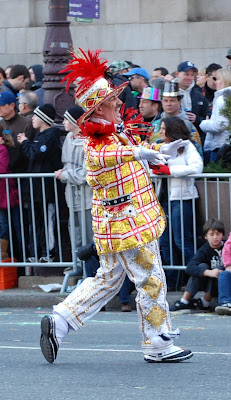Side by side, in their nameless graves, the lovers are sleeping.
Under the humble walls of the little Catholic churchyard,
In the heart of the city, they lie, unknown and unnoticed.
 |
| "the little Catholic churchyard" |
These lines are from Longfellow's poem "Evangeline", which tells the story of two lovers separated when they were forced onto British ships bound for French Catholic settlements in what is now the United States. The British had just taken control of Nova Scotia in the mid-1700s, and these French Acadians were deported when they refused to pledge loyalty to England. Families were separated and Evangeline and her fiance from this Longfellow poem lost each other until he lay on his deathbed decades later. Most were sent to Louisiana where they became known as Cajuns, but many landed in other regions tolerant of Catholics: Maryland, New England, and Philadelphia. These were my ancestors on my father's side, and I was astonished to find out that this churchyard mentioned in the poem I've known for years is in Philadelphia beside Holy Trinity Catholic Church (1789), and that there are Cajuns buried there. "Unknown and unnoticed" indeed, especially to me!
 |
| Washington Square |
|
This area surrounding Washington Square in Philadelphia has a colorful history that I'm willing to bet is "unknown and unnoticed" by the many folks who live near it. I've always noticed a peacefulness about this square, and perhaps I would go as far as to call it somberness, but I never knew why. William Penn included five squares or parks in his original plan for Philadelphia: Northeast (now Franklin Square), Southeast (now Washington Square), Centre Square (where City Hall now stands), Southwest (now Rittenhouse Square), and Northwest (now Logan Circle). Quakers like William Penn would not name places after people (this happened much later), and described these spaces by their relative locations.
 |
| Dogs walking their owner |
|
Washington Square definitely lacks the hubbub of the other squares, and one would never expect to find a Rittenhouse Square-esque art fair or event here. My guess is that anyone aware of Washington Square's history would discourage such activity on this ground which conceals the final resting places of hundreds of souls. You will find the more contemplative set here: old men playing chess, people reading, dogs walking their owners, and people of all walks of life passing through.
It's true: this square was used as a "potter's field" or graveyard for poor folks and strangers to the city for many years until the Revolutionary War when soldiers from both sides were buried here in mass graves. Victims of the yellow fever epidemic of 1793 were buried here, too. People who died from deplorable conditions in the Walnut Street Jail were buried here until the 1820s when the jail was replaced by the Eastern State Penitentiary.
In 1954, the Washington Square Planning Committee set out to beautify the park and include a tribute to Washington and the Revolutionary War dead buried here. They imagined a Memorial Tomb to the "Unknown Soldiers of the Revolution" and brought in archeologists to dig up remains of an actual unknown Revolutionary War soldier to put in the memorial. So they dug and found skeletons wrapped in canvas, a clue that these would be the poor, or prisoners, or yellow fever victims. War dead were at least buried in coffins. At last a probable young American soldier's remains were found and placed in the memorial's tomb in front of the statue of George Washington. The eternal flame in front was added in 1976.
 |
| Memorial Tomb to the "Unknown Soldier of the Revolution" (1957) |
 |
| Lippincott Building (1900) |
Washington Square's history is not altogether gloomy. From the mid-1800s through the first quarter of the twentieth century, this place was a publishing hotspot. Lippincott, Lea & Febiger, Curtis (publishers of The Saturday Evening Post and Ladies' Home Journal), and the Farm Journal were here, and authors with the still-famous names of Edgar Allan Poe, Washington Irving, Charles Dickens, and Christopher Morley visited them and lectured nearby in the Musical Fund Hall on Locust Street.
 |
| The Athenaeum of Philadelphia (1845) |
The famous
Athenaeum of Philadelphia, an exclusive subscription library now a National Historic Landmark, still exists in a brownstone building on the east side of the square. This institution allowed Philadelphia's wealthy residents access to the latest books and periodicals in a club setting. Tours are available of this treasure on weekdays, and it provides some fascinating
online tours which can be found here. The
Athenaeum bookstore specializes in Philadelphia, architecture, and Philadelphia architecture.
































